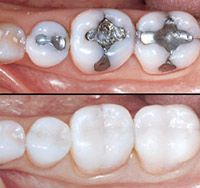Schedule Your a Consultation Today
(310) 854-6107
Inlays and Onlays Are a
Unique Dental Restoration Processes

Inlays and Onlays are unique dental restoration processes used to repair damaged teeth and prevent further tooth decay. Although similar, they each serve a particular role in restoring teeth to natural, healthy forms.
Inlays are used when the decay or damage is within the indented top surface (cusp) of a tooth. This is a smaller area to work in and inlays tend to be confined to that small area. Think of the tooth as a small cup and inlays are restorations done “in” the cup.
An onlay, on the other hand, extends beyond the rim of the cup, going over the tooth cusp or involving more than one cusp. Onlays are used when the cavity or damage reaches one or more cusps of the tooth or teeth. This often involves reconstruction of the cusp which has been worn or broken away.
If the cavity or tooth damage is more severe, affecting more than the area within the cusps, or just beyond, it may be necessary to have a crown placed. However if it is confined, a less invasive onlay or inlay may be used.
Composite inlays and onlays are made of a combination of plastic and zirconia/silica which is bonded to the tooth. They are tooth-colored in appearance and actually strengthen the structure of the tooth by up to seventy-five percent. Because of the composite materials from which they are made, they can last up to thirty years.
Unlike a traditional filling, inlays and onlays are created outside the mouth. Their shape is formed and hardened. Then it is adhered to the tooth, allowing precise shaping and design. Traditional fillings are placed in the tooth and then allowed to harden there. The other benefit of working outside the mouth first is that dentists can ensure that the composite used to create the inlay or onlay matches the color of your natural teeth. This gives a seamless transition between your teeth and the restoration, giving you a more comfortable, confident smile.
